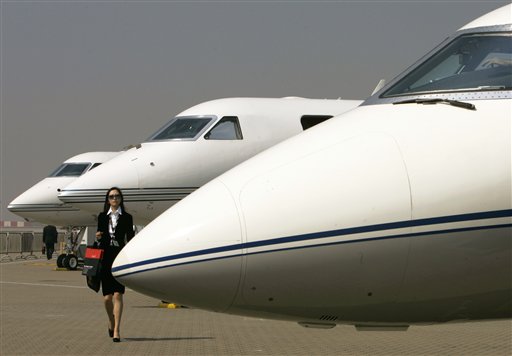
The blizzard that dumped 12 to 32 inches of snow on the East Coast in late December wreaked havoc on commercial air travel and left thousands of business and pleasure flyers stranded. But for those wealthy enough to afford it, there was an avenue of escape: private jets. "The blizzard was the best for our business," says Nick Tarascio, CEO of Ventura Air Services, a private-charter operator based in Long Island, N.Y., that ended up doing 200% more business than usual in December, thanks to that wintry blast.
Ventura wasn't alone in reaping the benefits of foul weather. Heavy snowfalls, ice and Arctic temperatures last month snarled commercial air traffic in both the U.S. and northern Europe. According to the European Commission, 35,000 commercial flights were canceled in Europe in December — more than all of 2009 — and British Airways says the weather cost it about $78 million. But as Ventura can attest, the snowy deluge provided a boom for the private-jet industry. In the U.S., charter departure requests peaked on Dec. 26 at 1,478 — more than double the number on that date in 2009, according to industry-data provider Avinode Business Intelligence. In Europe, the peak came a little earlier — on Dec. 21 — at 369, more than triple 2009's tally. "Crazy weather tends to help our business," admits Magnus Henriksson, Avinode's business manager.
Why can private jets fly when so many scheduled flights are grounded? They have greater flexibility because they can file flight plans a mere two hours ahead of takeoff. They also have many more alternate airports they can use. In Europe, for example, charter flights have their pick of about 3,000 airports, 10 times more than commercial airlines. And many of those second-string airports are smaller, which speeds snowplowing. "There aren't 50 miles of taxiway to clear," Tarascio notes. Moreover, commercial airlines will cancel flights if the cost of deicing planes crushes their already slim margins. That's not an issue for charter operators — many private jets are kept out of the cold in hangars, and if they do need deicing, operators have more leeway to pass along the extra cost.
December's gift from Mother Nature helped cap a year of recovery for the industry, which was hit hard by the Great Recession. Overall, global demand was up 50% last year, according to Avinode, though that increase follows a particularly poor 2009. "We're still not back to pre-recession levels," Henriksson says. David Macdonald, director of London-based operator AirPartner, says, "It's been a slow, steady and encouraging return to business."
Even if demand hasn't fully rebounded yet, fares nearly have, after operators were forced to cut prices during the downturn. Now those who can afford it are again willing to shell out about $99,000 to take a plane that seats eight — that's $12,500 per person — on a one-way flight from London to New York City. By comparison, a last-minute, one-way booking for a first-class seat on a commercial carrier would cost about $8,200.
Operators are hopeful that 2011 will bring even more growth, and Henriksson says the year has already started out stronger than 2010. Patrick Margetson-Rushmore, CEO of London Executive Aviation, says, "This is an ad hoc business, so it's hard to speculate on what spring and summer will bring. But I'm not pessimistic."
Another reason for industry optimism is Asia, particularly China and India. It's a market that didn't exist 10 years ago. It's still relatively small, but it's starting to soar. Asia is, however, hindered by red tape and inefficiencies. In China, flight plans have to be filed days in advance, there are too few airports and access to airspace is limited, says Eddy Pieniazek, director of Ascend, a U.K. aviation consultancy. Moreover, he adds, some mega-wealthy Chinese are bypassing charters completely: "They're stepping straight into owning their own jet." (Of course, many charter companies maintain and operate jets on behalf of private owners.)
Back in the U.S., Ventura's Tarascio is hoping for more inclement weather. "We'd love to have some more snowstorms," he says. He may get his wish — for years to come. Some experts say that while global warming is triggering a meltdown in the Arctic, it may cause several years of colder, snowier winters in the Atlantic's northern midlatitudes. For most of us, that's a cloud of bad news. But for the charter industry, it has a silver lining.
By THOMAS K.GROSE
Back to other news













